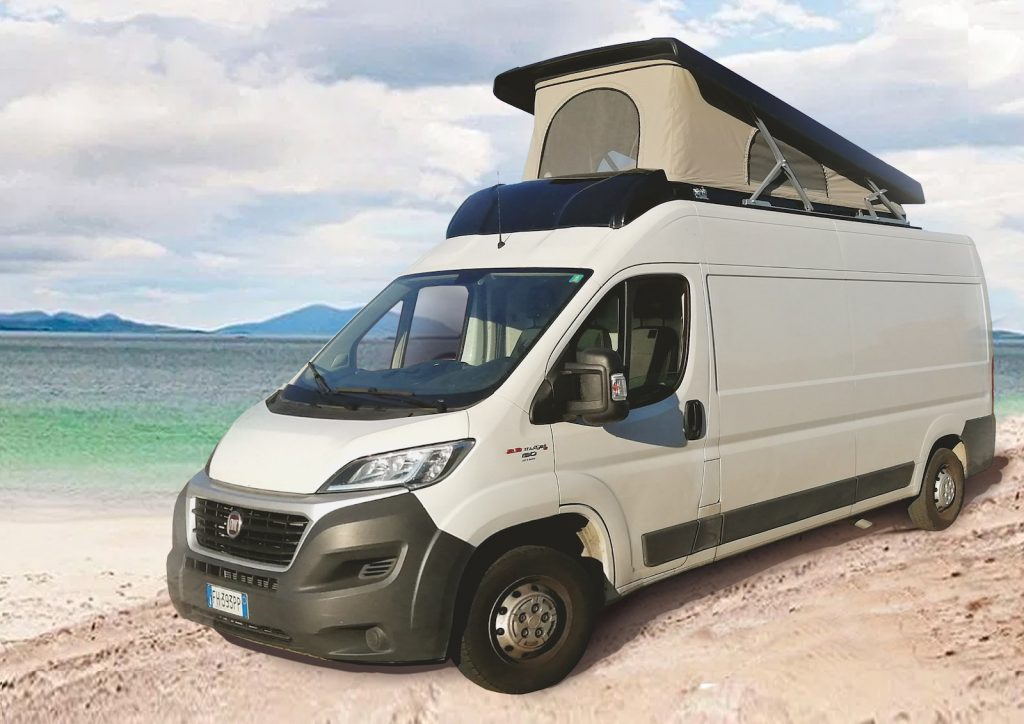Wombles
LIFE MEMBER
New for some manufacturers (yet to be named) as factory fit for 2021 Fiat Ducato, Peugeot Boxer & Citroen Relay (H2 type) roof van conversions - it may be available as an aftermarket option for these models in the future. If it works as well as they claim (negating some of the issues with current versions of this roof) then maybe this could be the next trend for motorhomes? Article below has been translated from French:
Lippert Components (LCI) closely follows new trends in vans. For this type of leisure vehicle, the company has already designed several products, including “ slide-out ” applications. This “expandable space” concept is now expanding in height with the development of a new pop-up roof, manufactured not in fiberglass, like most current products, but using the “ twin sheet ” thermoforming technique. ". This new generation roof is primarily intended for manufacturers before a possible deployment in aftermarket.
20 to 30% lighter
Twin sheet thermoforming , which can be carried out using the vacuum or pressure technique, provides for separate production of the two sheets. Once obtained, the top sheet and the bottom sheet are quickly brought together so that their surface temperature does not decrease. A corrugated jig serves to maintain a free space between the two, into which high pressure air is introduced to strengthen and weld the two parts together.
This technique saves weight, " by 20 and 30% less compared to other similar fiberglass products " explains Lorenzo Manni, Commercial Director of LCI RV Europe.
This process has enabled LCI to produce a larger than average pop-up roof, capable of accommodating a 200 x 130 cm double bed, without increasing its weight.
From a mechanical point of view, LCI has developed a lifting system using an integrated double mechanism, which makes it possible to recover space in height, including on the lowest side of the roof.
The presence of an air mattress also at the base level has therefore made it possible to develop an exclusive patent pending solution: in this space, it is possible to introduce hot or cold air, depending on the season, and to improve the air conditioning of the upper space, the temperature of which is then closer to that of the passenger compartment of the van.
 Vela roof
Vela roof
An optional insulating fabric
Its internal layout provides for internal lighting, illumination of its perimeter, reading spots, smartphone charging sockets and air vents. The fabric of the ceiling is washable and removable. As an option, an additional insulation fabric is available, provided with a waterproof outer layer and an insulating inner layer, welded together, to reduce heat exchange between the interior and the exterior.
To begin with, the “Vela” pop-up roof will only be available for Fiat Ducato, Citroën Jumper and Peugeot Boxer with H2 roof, but in the future LCI will make specific frames and deflectors also for other camper van models, as well. than for other manufacturers.
Lippert Components (LCI) closely follows new trends in vans. For this type of leisure vehicle, the company has already designed several products, including “ slide-out ” applications. This “expandable space” concept is now expanding in height with the development of a new pop-up roof, manufactured not in fiberglass, like most current products, but using the “ twin sheet ” thermoforming technique. ". This new generation roof is primarily intended for manufacturers before a possible deployment in aftermarket.
20 to 30% lighter
Twin sheet thermoforming , which can be carried out using the vacuum or pressure technique, provides for separate production of the two sheets. Once obtained, the top sheet and the bottom sheet are quickly brought together so that their surface temperature does not decrease. A corrugated jig serves to maintain a free space between the two, into which high pressure air is introduced to strengthen and weld the two parts together.
This technique saves weight, " by 20 and 30% less compared to other similar fiberglass products " explains Lorenzo Manni, Commercial Director of LCI RV Europe.
This process has enabled LCI to produce a larger than average pop-up roof, capable of accommodating a 200 x 130 cm double bed, without increasing its weight.
From a mechanical point of view, LCI has developed a lifting system using an integrated double mechanism, which makes it possible to recover space in height, including on the lowest side of the roof.
The presence of an air mattress also at the base level has therefore made it possible to develop an exclusive patent pending solution: in this space, it is possible to introduce hot or cold air, depending on the season, and to improve the air conditioning of the upper space, the temperature of which is then closer to that of the passenger compartment of the van.
 Vela roof
Vela roofAn optional insulating fabric
Its internal layout provides for internal lighting, illumination of its perimeter, reading spots, smartphone charging sockets and air vents. The fabric of the ceiling is washable and removable. As an option, an additional insulation fabric is available, provided with a waterproof outer layer and an insulating inner layer, welded together, to reduce heat exchange between the interior and the exterior.
To begin with, the “Vela” pop-up roof will only be available for Fiat Ducato, Citroën Jumper and Peugeot Boxer with H2 roof, but in the future LCI will make specific frames and deflectors also for other camper van models, as well. than for other manufacturers.
Last edited:




